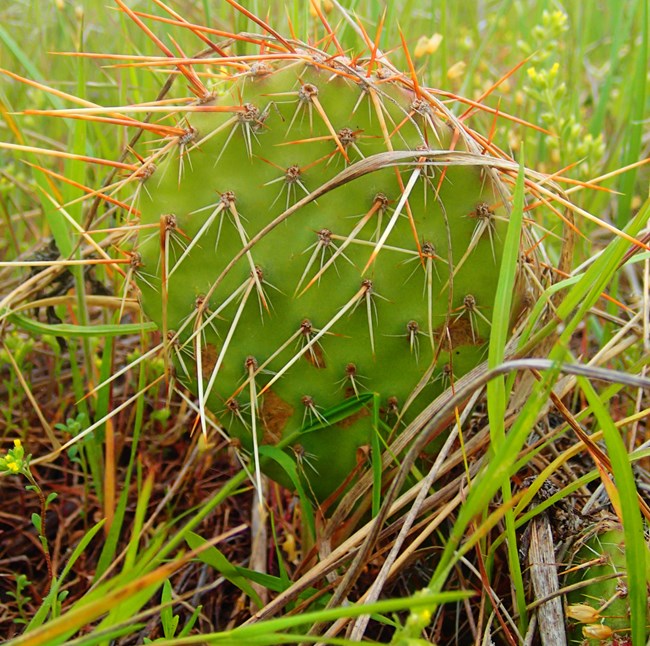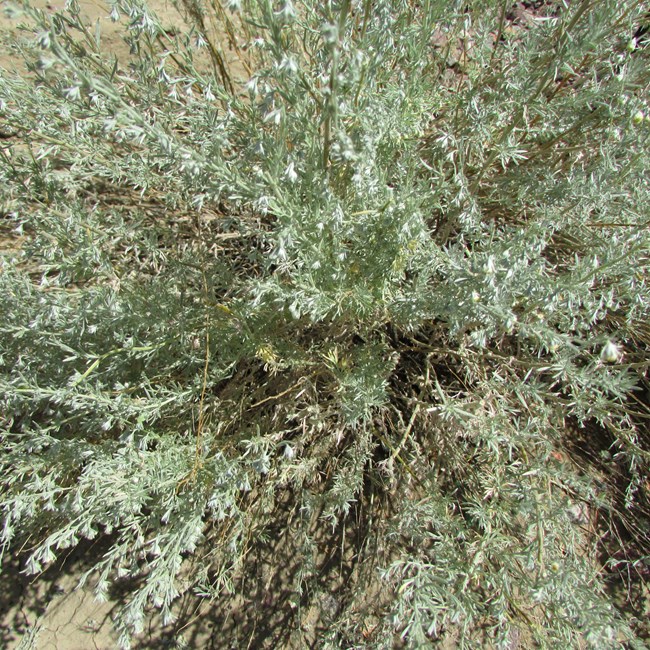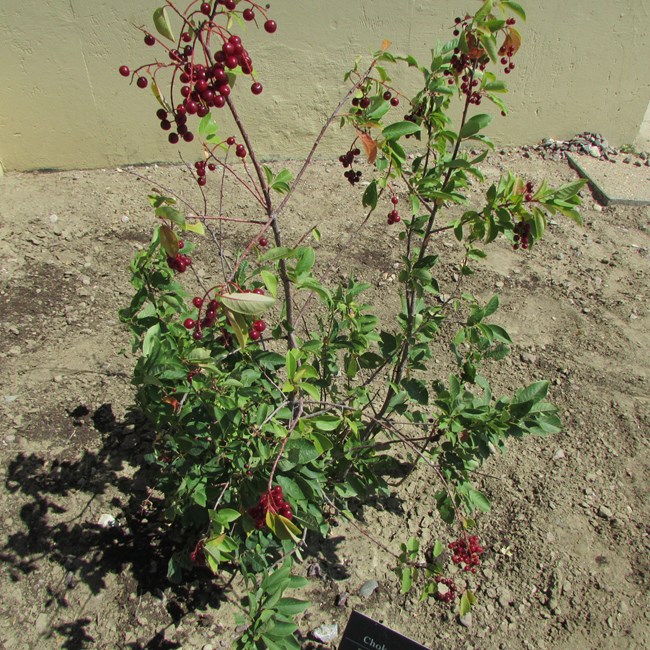|
The native plant garden at Little Bighorn Battlefield National Monument is composed of indigenous species that play a significant role in the lives of the Plains Indians that used this area. Below is a short description of some of the cultural uses for the plants located in the garden. In addition, the garden includes three grass species native to Montana. Prairie Junegrass (Koeleria macrantha, 13), Green Needlegrass (Nassella viridula, 6), and Bluebunch Wheatgrass (Pseudoroegneria spicata, 3) serve to represent the historic biodiversity of the Great Plains. Please note that the appearance of much vegetation varies seasonally. Plants may not appear exactly as depicted. For more information about plants in Montana, please visit fieldguide.mt.gov. 
NPS photo Rocky Mountain JuniperJuniperus scopulorum
buluxpée (holy wood) (Apsáalooke)
be'see3 (Arapaho)
šéstόtό'e (Cheyenne)
Rocky mountain juniper is a small tree with blue berry-like seeds. The Arapaho used the needles as a ceremonial incense to scare away ghosts, for purification after burials, and as a disinfectant. The Arapaho also used the aromatic needles to help treat respiratory problems. The berries were used in a tea for sore throats and stomach ailments.

NPS photo Plains Prickly PearOpuntia polyacantha
bichkiliiá (Apsáalooke)
ho'yoox xoo nee (Arapaho)
hon nei xo'o no'o (Cheyenne)
heškόvemata (Dakota)
A cactus with rounded pads and long spines, the prickly pear was used for many applications. The Cheyenne used the plant as a thickening agent and emergency source of water. The Arapaho boiled the cactus and used the paste-like product as a lotion for burns and tired muscles and joints. Apsáalooke used the juice from this cactus to waterproof painted rawhide cases. 
NPS photo SkunkbushRhus trilobata
íaxxassaaisbale (Apsáalooke)
bee'éí'i (Arapaho)
no'aneonό'e (Cheyenne)
Skunkbush is a member of the sumac family;most species of which yield colorful and astringent berries. The berries were often used to treat stomach ailments. More commonly, they were steeped in water to make flavorful teas. Apsáalooke used the inner bark in a tea to relieve diarrhea.

NPS photo Fringed SagebrushArtemisia frigida
ammitaaniisahchaxuuwe (Apsáalooke)
nookhoose' nee'ee'boi (Arapaho)
he'évánό'êstse (Cheyenne)
nasula jazanpi ipije peji'ho'ta wastemna (Lakota)
The Cheyenne call fringed sagebrush "woman sage" for its use with the sacred woman during the Sun Dance. They also used it to increase appetite. The Lakota used sage smoke for purification, driving away evil influences. Apsáalooke used it to stop bleeding and heal infections.

NPS photo Prairie ConeflowerRatibida columnifera
baauchpashíile (yellow tip) (Apsáalooke)
šé'šenovotséheséeo'ȯtse (Cheyenne)
wahcha-zi chikala (Dakota)
hapo'stan (Lakota)
The Lakota made a tea from the stalks and leaves of prairie coneflowers to help cure stomach aches. They used the flower tops in a tea to alleviate headaches also. The Cheyenne boiled the leaves and stems to make a liquid. The liquid was applied externally to relieve poison ivy and to draw poison out of rattlesnake bites.

NPS photo Rubber RabbitbrushEricameria nauseosa
iísachchaxuushiile (yellow bunched stems) (Apsáalooke)
vόhkoohémenό' ėstse (Cheyenne)
One of the only fallblooming plants in the garden, rubber rabbitbrush was used by the Cheyenne to treat many ailments including itchy skin and smallpox. They also would burn leaves and branches to help repel nightmares. Apsáalooke used it to alleviate eczema.

NPS photo YarrowAchillea millefolium
chihpachiiskisshe (Apsáalooke)
no'outihii (Arapaho)
he'haéheséo'ȯtse (Cheyenne)
taopi pexuta (Lakota)
Yarrow was generally known as cough medicine, but was used to remedy many ailments. The Apsáalooke used yarrow to treat sunburns, stings, bites, and open wounds. The Arapaho used it to stop bleeding and hemorrhages. The Cheyenne made a tea from the above-ground portion to treat respiratory diseases, heart problems, and chest pain.

NPS photo Soapweed YuccaYucca glauca
úuxisbatshuakisshe (deer's awl);úuxisbachuakissh (deer's sinew) (Apsáalooke)
noo' xei no'xou (Arapaho)
hestáhpánό'e (Cheyenne)
hupe'stola (Lakota)
Soapweed yucca was mainly used for hygiene as soap. The Apsáalooke, Arapaho, and Cheyenne used the ground roots in shampoo to stop graying and hair loss as well. The Cheyenne also used yucca to treat skin ailments. The Lakota also used it in tea to treat stomach aches.

NPS photo Western SnowberrySymphoricarpos occidentalis
bishkaxchíia (Apsáalooke)
méhmemenȯtse (Cheyenne)
The Dakota used a tea made from snowberry to heal sore eyes, while the Apsáalooke used it as a cure for sinus problems and head colds.

NPS photo Curlycup GumweedGrindelia squarrosa
baauchpashíilitshia (stinky yellow flower) (Apsáalooke)
ȧhkévό'ėstse (Cheyenne)
pte ichi yuha (Lakota)
The Lakota used the bitter curlycup gumweed in a tea to help people spitting up blood, whereas the Apsáalooke used it to treat stomach aches and postpartum pain. The Cheyenne also used gumweed to make a topical remedy for scabs and sores, and rubbed the gummy residue on their eyelids to relieve snow blindness.

NPS photo White SagebrushArtemisia ludoviciana
iisachhaxuuwiilichitche (Apsáalooke)
hisei nookhoose' (Arapaho)
hetanévánό'êstse (Cheyenne)
The uses of sage for physical and spiritual cleansing are of great cultural importance for Plains Indians. Apsáalooke, Cheyenne, Arapaho, and Lakota all variously bathed or smudged with sage. The use of white sage as incense was common in many Cheyenne purification rites. Sage is widely used during the Sun Dance.

NPS photo ChokecherryPrunus virginiana
baáchuutaale (genuine berry) (Apsáalooke)
biino (Arapaho)
menȯtse (Cheyenne)
canpa'hu (Dakota)
The chokecherry tree was a crucial plant for the Plains Indians. Ripe chokecherry fruit was often eaten by itself or mixed with bison fat and meat to make pemmican;unripe fruit was used to treat diarrhea in children. The Arapaho also used them ceremonially during the Sun Dance. Chokecherry wood also was the material of choice when making arrow shafts.

NPS photo Golden CurrantRibes odoratum
bichéechihte (Apsáalooke)
ne'ibiis (Arapaho)
heόvėhestaahtsémeno (Cheyenne)
Golden currant, also known as buffalo currant, is a tall deciduous shrub with yellow trumpet-shaped flowers. The leaves and berries of this plant were often eaten when fresh, as dry preserves, or as sauces. They are rich in vitamin C.

NPS photo Broom SnakeweedGutierrezia sarothrae
bishéewaaluushissee (grass the buffalo won't eat) (Apsáalooke)
méhmemenό'ėstse (Cheyenne)
peji zizi (yellow herb) (Lakota)
Broom snakeweed is a small shrub with bright yellow flowers. The Dakota used the flowers as a laxative for horses, and the Lakota made a snakeweed tea to relieve colds and dizziness. The Cheyenne used snakeweed in altars during the Sun Dance. Apsáalooke used it to treat sinus infection, kidney pain and sore muscles.
The Little Bighorn Battlefield Native Plant Garden was made possible in part through consultation with several tribal partners. Additional references include Kindscher's (1992) Medicinal Wild Plants of the Prairie, and Smoak's (2016) An Environmental History of Little Bighorn Battlefield National Monument.
|
Last updated: July 3, 2025
